I promised a while ago to show a few pictures of the work I used to do- building suspension bridges and cable stay bridges, mostly on trails, pedestrian size. So here it goes. I was never very good at stopping to take pictures at this job, I did it for about 4 years, worked on probably a dozen bridges, and got decent pictures of two.
This one is a cable stay bridge about 220′ long, about 45 west of Chicago, in a nature reserve. It’s a pretty straightforward bridge, easily accesible site. From the abuttments up it took 4-5 people about 3 weeks to build. Took quite a bit longer to fabricate it, but that’s another story, and I have no pictures of that.
I had been out at the site a month earlier to set the helical piles that tie into the abuttment, but someone else did the forms and pour. Once we had fixed their mistakes, we started setting towers. Theyre about 30′ tall.
Here’s a shot of the backstay anchor block. The rod is attached to an “earth anchor”, a big steel trapezoid filled with concrete and buried about 12′ below grade.
Next shot of the tower, after installing cross braces. Two people rappel from the tower tops while braces are boomed up, so we work from the top down. We had to sit in the truck for a couple hours waiting out a series of thunderstorms. On top of a 30′ steel tower in driving rain and with lightning fast approaching is not a fun place to be. Ask me how I know.
A lot of time is spent rigging and preparing for the next step. Here we’re rigging a skyline for the main stringers, already up is a personnel line. Under the yellow tarp is a motor typically used for sending window washers up and down skyscrapers.
And here’s yours truly in the basket, getting ready for the maiden voyage. All the hardware just over my head is for sending out the main stringers.
To be continued. . . .
zak
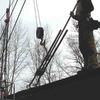
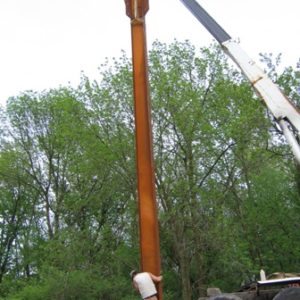
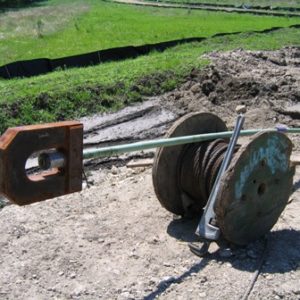
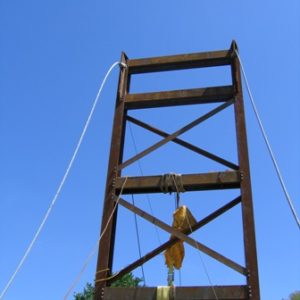
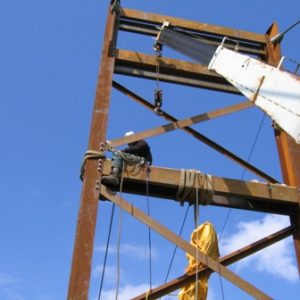
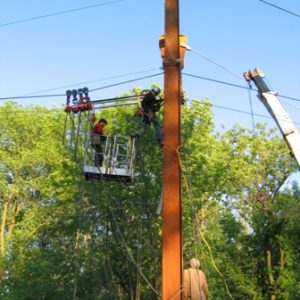



















Replies
As the story unfolds. . . .
The center three stringers get bolted together on the ground, then sent out as one piece. The splice plates are made to set the stringers at an agle to each other, so the bridge has the appropriate camber. The hole in the middle of the splice is where the clevis pin on the end of the cable stay lives, if you look closely you can see cutouts on the beam top to let the bridge rods pass by.
View Image
And there she goes. The stringer will coast almost to center, it's held back by a kubota kh-91 tractoring up the approach. In this picture you can see how close we are to the ground: we often build these bridges because we can erect the bridge with nothing in the water or wetland areas, in fact we don't need to touch the ground in between the abuttments during the construction.
View Image
A little while later, stringers have been installed from the far shore, and most of the stays are up on this upriver stringer. The splice plates are usually preinstalled on one of the stringers, they're a pita to haul around in the basket.
View Image
Nice shot of the bridge.
View Image
Walking out the intermediate stringers. We usually build the bridges like a railroad- do a few bays of beams and diaganols, then intermediate stringers, railing posts, and decking before moving onto the next few bays. This means we can move our stockpile of parts out on the bridge close to where we're working, and we don't have to walk beams all the way across all day.
View Image
Here's what I mean:
View Image
A few more yet to come. . . .
zak
I've just got a couple more shots of this bridge.
The decking and rail posts only take a couple days to finish, putting out the main stringers and hooking up the cables is probably the most time consuming part of the process.
Here's the bridge with all the rails on (6x6 treated SYP for handrails) and the cable railing run through all the posts. We're swaging the ends on those cables.
View Image
Final shot of this bridge, railing cables just tightened. We spend a day or two adjusting the cables to get the camber to the correct height, and tighten everything down.
Completed at the end of last may.
View Image
I'll post a few pictures of another bridge in a day or so.
zak
Fascinating. Keep them coming please. About build time. What is the time to make a bridge from the time the contract is signed to the completion?How much of that is in the fabrication shop?How long does the erection / assembly take?Is each bridge a custom design from scratch with all the parts unique to that bridge, or is it a variation of a standardized design adapted to suit the location with common components?Hope your OK with the questions. It's quite different from aircraft work that I do.
Build time- it seems like it usually takes a couple of years between the inception of an idea and the bridge being completed, but there is a lot of time that goes into permitting, etc. Design and design review usually take a couple months to be complete, materials ordering takes a while (the shop is in seattle, all the weathering steel has to be shipped from the east coast), and we have several projects going at any one time.
The fabrication for a bridge might take a couple months in the shop. This includes not only welding towers and cutting beams, but often the cables are fabricated at the shop. I've got a few pictures of making cables at another bridge (these were made in the field), here they are.
The casting is on, cable is broomed out and cleaned off in muriatic acid, then rinsed and dried off:
View Image
Here's me, with the cable rigged up to make the casting level, pouring molten zinc into the cable end (had to set up a tent to keep the rain off).
View Image
A pile of completed mainlines and bridge rods. This happens to be a suspension bridge, not a cable stay bridge, so we had to socket far fewer ends.
View Image
Once fabrication is done, it takes from 3 weeks to 3 months to erect the bridge, depending on the bridge type and size, accesibility, work remaining to be done, etc.
This chicago bridge took about 3 weeks, because we had as much ready as possible when we got there. Actually, the first bridge I worked on, in Colorado, took only 8 days to erect. it was only 60' long, a simple suspension bridge, and we could just about set the towers up by hand.
Each bridge is more or less unique, although the designs don't look that different for most of our cable stay or suspension bridges- the size of every part is tweaked for a different size bridge. Almost all the components (except for the castings) are fabricated in house, there is really no source for small suspension bridge parts.
The bridges are usually built with between 3 and 5 people, because there are so many sequential processes, where you're waiting for something else to be done. It would be hard to keep more people busy.
zak
Slightly off the topic but your thread got me thinking about it. I thought it would be cool to build a house over a creek like a covered bridge. Great views and no lawn to mow. It will have to wait until I win the lottery though.Great thread. Thanks for taking the time to answer my questions.
Ever been to Fallingwater?
Very cool, zak. Thanks.
I'd like to see any other photos you have. Suspension bridges are so cool. I think it's because you can see most of the structural parts, similar to a house frame.
That's quite a bridge they are building in Tacoma right now. I have read they think it might be the last big suspension bridge built on this continent because all the spans that would use that type (whatever type that is) have already been built.
Anyways, thanks for the great thread.Tipi, Tipi, Tipi!
http://www.asmallwoodworkingcompany.com
I'll post a few more pictures tonight. There are also some pictures on the company's tragically outdated website, http://www.sahale.com.
I agree with you that the enchanting thing about bridges, and especially suspension bridges, is that they are pure structure, and that's what makes them beautiful. Like in some japanese carpentry, the structural and finish materials are one. Kind of like the early modernists said, to use only the highest quality materials, and let those materials show through, with no unnecessary decoration.
I've only seen that Tacoma bridge when there were pictures of it here, and then I guess I saw it from an airplane last week. That's big stuff there. That's to bad if it's the last of its size. Seattle needs a bridge like the golden gate or Verazano Narrows.
zak
Here's a few more suspension bridge pictures- there are two bridges at this site, each spanning a different branch of the Big Hole river to an island in the middle. They're big enough for a cement truck to drive over, one is 180', one is 110'.
Putting up stays:
View Image
Rigging up center stringer. Did I mention that we did this in winter and spring? I hate working on steel when it's 8 below.
View Image
Hauling the steel up- it needs to be all the way up to get the stays attached:
View Image
A few days later, upstream stringer up, downstream almost done:
View Image
More to come,
zak
Tightening up the stringers that have just gone out :
View Image
spudding in the next stringer. The spud is the big pointy steel thing in my hand, it draws the holes into alignment when pounded in.
View Image
Completed stringer and a little taste of the rope and cable and chain birdsnest:
View Image
Guiding in a cable stay- this one is only about 30' out from shore, so we're pulling it into place with the boom. Normally we use a grip-hoist, an amazing little come along sort of thing.
View Image
A few more yet.
zak
Bridge deck going on, and pipes for utilities laid down:
View Image
In this picture, you can see how the beam that the guy is standing on is still hooked up to the boom truck. We've built the deck out as far as we can, and then we'll put down beams, diagonal braces, and intermediate stringers down as far as the boom can reach (about 30' at a time), and then deck it. Beams from the other side were put out as far as we could reach from the shore.
View Image
An almost completed picture of the larger (180') bridge. The other pictures are of the smaller bridge.
View Image
View Image
One of my favorite shots from this bridge- through a clevis pin hole in the main stringer:
View Image
Well, that's about all the pictures I have, sadly. Thanks for watching.
zak
Zak
That picture through the clevis is very good. Thanks for the pictures.
Oh, you guys are some funky hat wearing dudes!
Doug
Kind of sad to see the pictures end.There are two cable stayed bridges in the Vancouver area of BC that cross the Fraser River, with a third that they have just started to prepare for to be built. One is for the Sky Train rapid transit system. The other and the new are road bridges. When you mentioned that you saw the Tacoma Narrows Bridge from the air it reminded me of something some airline pilots said about the existing road bridge. When they are on approach to Vancouver Airport, especially when the weather is poor, they use the "goal posts" to line up on the runway when landing. If they are over the bridge they are on the right vector. If the towers are off to the side they aren't.
Yeah, I should have been better about taking pictures, these weren't even my favorite bridges. I worked on one near Lincoln City Oregon called the Drift Creek bridge, it's a 240' suspension bridge only about 3' wide, more than 100' above the creek. Just off to the side a 70' waterfall comes in. In nice weather it's gorgeous, but while we were working on it it was raining about an inch a day.
Here's a photo of the bridge that someone else has posted on the web:
View Image
And looking down at the falls from the bridge:
View Image
It's a great bridge to rappel off of, when you get 20' down from the bridge or so, you can just spin around and get an incredible 360 view.
zak
Wow, wow, wow. I am just all agape and awed. My partner did bridge building. And I get a shaky on one story buildings. And the iron work. Wow. That is something. I am wordless.
I just caught your posts and ....wow!
but I gotta tell ya...me testicles is hiding way up somewhere and won't come down just from LOOKIN at those pics...
me and heights are ok...but me and heights on a beam...no way...
my hats off to you and the boys!knowledge without experience is just information.... Mark Twain
http://www.cobrajem.com
Thanks for the compliments Charlie and Armin.
I was actually not that comfortable with heights when I began, but I figured I could work my way through that, and I pretty much did. I'm pretty comfy if I've got a safety system that I've set up myself, and I used to do some rock climbing, so I could spend all day in a harness with no problem.
Like we always said at work- "the most dangerous part of the job is the drive".
Being a little bit afraid adds to the thrill, anyway.
zak
LOL, When I was doing commercial roofing once, the veteran roofers used to say, it's not the fall that kills you, it's the sudden stop.
That reminds me of a quote from one of the Douglas Adams books (Hitchiker's Guide to the Galaxy): the trick to flying is to throw yourself at the ground and miss.edit: didn't know if you had a professor at Cooper named Alexander Gorlin. He had an interesting piece in the recent 25th anniversary edition of Metropolis.
Edited 3/28/2006 12:15 pm ET by draftguy
Great pics Zak, I have been framing houses for 20 years, and I have thought of building a house using cables, so as to give an open concept, and all support coming from the roof, and then back down to the ground using cables...
You really know how to hurt a guy . . . i'm feeling guilty for looking at these on office time, and now i'm jealous too. Your photos are awesome.You mentioned you don't work for this company anymore. Are you still doing bridges then?
As of October, I'm not doing bridges anymore, I'm remodeling my own house full time. Building bridges is tough to balance with any sort of home life- on some of these projects I would be gone, living in a trailer or hotel room for 4 weeks straight, working 12 hours every day. It wears on you, and I don't think I'm cut out for doing that the rest of my life.
The occupation has a lot of glory, and I'm proud to have done it, but on the other hand, most of my time was spent turning bolts- now that I'm more of a carpenter and woodworker, I appreciate working with natural materials on a small scale so much.
I'm glad you enjoyed the pictures.
zak
Very interesting work Zak, thanks for sharing the pics. I look forward to seeing your house pics. Just did my own house full time over the last year so I can relate to what you are saying.
Have you posted pictures of your house yet? I think I learn as much from looking at all the beautiful work here as I do talking about techniques. Always nice to see more quality DIY work- often it's done with creative solutions that differ from the typical pro ways, and that can be interesting.
zak
I've posted a couple of details here and there but not the whole thing yet. If you are interested I will. Where are you building yours and what are you doing in terms of style and scope. I'm curious as to how your transition to carpentry from the bridge building gig came about. Were you a carpenter before, or is it a new found career change? Again, the pictures were great, I've always said that I would love to build a bridge in my lifetime, seems like you've done a few.
I'm not building mine, "merely" a large renovation, inside the old exterior walls. 1915 bungalow in north central washington. I restore what I can, rebuild what I can't. I would put it in the moderately complete category- I've gone down to the studs in about half the rooms, and moved quite a few walls. I'm a complete slowpoke compared to many of the people here.
I was a trail builder before I was a bridge builder. While building trails in the wilderness, I started building log bridges, all hand tools, that sort of thing. I built trails for about 6 years, and then I got the bug to build more bridges. I found sahale, which used to build a lot of log bridges, but when I contacted them, they were doing mostly steel suspension bridges. That sounded pretty good to me, and a couple weeks later I was headed to colorado in the middle of winter to build a bridge.
Post some pictures, tell a little story, it's fun.
zak
Zak, I did 4 years in Berkeley. Our department was right next to the architechture school. Its one ugly building! Living in Berkeley is rather high stress. And high cost. We lived in Oakland to keep it affordable.Those who can make you believe in absurdities can make you commit atrocities- Voltaire
That's extremely cool. I used to work in the overhead crane industry; our old engineering standards had instructions on how to do a molten zinc fitting, but we'd gone to all swaged fittings ages ago. One of our products was a competitor to the Grip-Hoist called the Tugit; they are truly handy things if you have to move something heavy. I keep a 3/4 ton capacity one in my car in winter!did<!---->Cure Diabetes - Death Valley 2006!<!---->
Those poured zinc sockets are really nice- they take a little longer, but they're full strength, and there's just no other way with the big stuff. I'll have to look up the tugit- all we had were griphoists, though I've used jethoists before too. handy things, I wish I had one. I miss the rigging, that's fun, challenging stuff.
zak
Tugit's a chain lever hoist; my 3/4 ton deal would drag a small car with locked brakes, plus it was rated for overhead lifting. We made them in up to a 6 ton capacity, which you had to crank on forever to move anything!did<!---->Cure Diabetes - Death Valley 2006!<!---->
Jim,
Not sure whether this one meets your criteria for a big suspension bridge, but after at least a decade of political BS it's on it's way:
http://www.newbaybridge.org/redesign/design_finalized.html
The suspension portion is only about a half mile long, but should be pretty impressive.
(Me, I just take the train - trying to drive around here really sucks!)
Wayne
Damn! Those pictures really blow my jets! These are just the coolest structures. For bridge aficianados, there is a really world class slugging match right now between Sir Norman Foster and Santiago Calatrava to see who will build the next coolest structures. These guys are just way over the top. http://www.calatrava.com and go to bridges. Then go to Popular Mechanics and look at Foster's new Hearst building in NYC. NO VERTICALS IN ANY PART! All triangles, which decreases the weight of the steel needed by 20%. http://www.fosterandpartners.com/
For anyone who cares, a suspension bridge has a deck that is unloaded. Its hanging from the cables. The cable stayed bridges have the deck under compression, as the vector from the cable is part horizontal, part vertical. Makes a difference in winds and quakes.
Zak, if you can get us a cable stay in Seattle to replace our viaduct, you are the man! A cable stay or suspension across Elliot Bay could be really beautiful.
Those who can make you believe in absurdities can make you commit atrocities- Voltaire
Edited 3/18/2006 1:17 am by etherhuffer
Edited 3/18/2006 1:23 am by etherhuffer
A buddy of mine is working on the Hearst building, I'm going to get a tour of it in the next week or so. Unfotunately it will be closed to the public. The Metropolitan museum here in NY had a show on over the winter about Calatrava. I am a fan of both them also. I moved to NYC cause I love the bridges.
That is way too cool. So no tours of the Hearst? That is too bad. Its a real eye popper
Another fun fact about some of the cable stays. Some have dampeners in the cables to make up for traffic vibrations. Guess who makes them? KONI of the same folks that do car shocks! And the dampeners are HUGE!Those who can make you believe in absurdities can make you commit atrocities- Voltaire
Have you seen that suspended arch bridge near blackstock lumber, on elliot wy? It's similar to the bridge on Santiago Calavatra's frontpage.
Also, though most cable stayed bridges have a lot of compression against the abuttment, our cable stayed bridges were built to be in tension (steel is stronger that way, so it's more efficient in a small bridge that has a steel deck, no concrete), that's why we put out the middle stringers first, rather than building from each side to meet in the middle. The stringer ends actually float, the ends are made to not hit the abuttment horizontally, weight is only transferred vertically. Small, unstiffened deck suspension bridges are a different game than the big stuff.
From the little I know of large suspension bridges, I think that the cable suspension portion is made to support the dead load of the bridge, and the truss of the bridge deck is made to support all of the live load of cars and such- this way the weight of live load doesn't move the whole bridge too much.
zak
Very cool. Thanks for the photo.Tipi, Tipi, Tipi!
http://www.asmallwoodworkingcompany.com
You know, it had slipped my mind that the new bay bridge was going to be suspension. I'm moving to that area in the fall, maybe I should try to get a job playing with cables down there.
zak
Zak,
Are you sure you know what you're doing? With all due respect, from Central WA to the SF Bay Area is a pretty brutal transition, especially for housing costs and gridlock. (hint, hint - too crowded here already <G>). LOTS of construction, commercial and residential, so good job opportunities. Where 'bouts?
Wayne
Thanks for the warning, man, LOL. I'm following my wife, she's starting a Ph.D program in Entomology at Berkeley. I would be happy to stay put for the rest of my life, but on the other hand, being young and all, this is probably a good time to check out city life. And a good place to get some good work experience, and possibly go to archy school while I'm there. If you're down there, I'll be looking you up this fall.
zak
"Ever been to Fallingwater?"Nope, can't say that I have. Now I'm going to have to do a little research to see why you mentioned it. I had in mind something along the lines of an old wooden covered bridge, and I'm pretty sure that's not what Frank would have been into.
Fascinating stuff. Any way you can post some of the engineering stuff for these? It would be neat to see how the designs are done...
Q: Why do blondes drive cars with sunroofs? A: More leg room.
I don't have the expertise to talk in detail about the engineering of cable stayed suspension bridges, we had an in house PE doing most of that. I don't work at the company any more, it was time to move on, so there isn't much I can show you. But I think I might be able to answer more specific questions about it, if you have any.
zak
I don't have any soecific questions - I was jut curious in general what kind of engineering goes into stuff ike that. The only bridge I've seen engineering for was a concrete slab thing, and it wasn't too exciting.
The reason girls don't do well on multiple choice tests goes all the way back to Genesis, Adam and Eve. God said, "All right, Eve, multiple choice or multiple orgasms, what's it going to be?" We all know what was chosen. [Rush Limbaugh]
As far as that goes, the design starts with seat-of-the-pants engineering by the company owner, who has been building these things for quite a few years. Ideas get thrown around for a while with the drafter and the owner's dad (retired PE) on how to make things work well with an efficient design.
These bridges are different from a highway bridge in that they usually don't have a reinforced truss, so the bridge deck must be made to flex with the deflection of the cables. A suspension bridge moves much more than a cable stayed bridge, so we usually build these cable stayeds when a more rigid or beefier bridge is needed.
Once a general design is sketched out, the bridge is modelled on computer (I think the program is RISA), and the engineer checks everything independently.
Hopefully that gives you some idea of the process- most of the knowledge base of this company is in the people who fabricate and erect the bridges, and so they are where the design usually starts.
zak
A lot of the concrete bridges are actually suspension bridges. The cable raceways are cast into the concrete I beams. These look like a suspension bridge if you had X-ray vision. They post tension the cables after everything is in place.
Zak,
Do you mind if I ask where this is exactly? As I live in the western suburbs of Chicago, this looks familiar.
Joe
Mmmm... steel. I love steel bridges. Weathering steel is the greatest for settings like that.
Looks like fun. Please post more....that's not a mistake, it's rustic
I think the place is called the Big Rock nature reserve, or something like that. It's a couple miles from Big Rock, which is a few miles from Aurora. I think it's Jericho road that you can follow right out to the site, but I won't guaruntee it.
zak
Don't know how I missed this. Great job Zak. Timber frames are my favorite as my grandfather used to build them in Germany at the turn of the century. Worked on a few myself not to your degree but enough to appreciate what goes into building one.